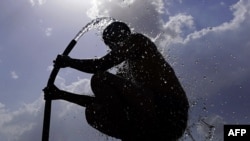Millions of people worldwide get no early warning when disaster is about to strike, according to a new survey.
The Lloyd’s Register Foundation World Risk Poll, conducted by the Gallup polling organization, found that in 2023, 70% of those surveyed received an early warning before a disaster, while 30% did not.
In 2021, the number of those who received an early warning was nearly the same at 69%.
Yet the number of people facing natural disasters is rising.
“What we’ve found from this year’s poll is that globally, the number of people experiencing disasters in the past five years has increased significantly,” Benedict Vigers, the author of the report, told VOA.
"More people are going through these events. Therefore, it becomes more important to understand how people are experiencing different types of disasters," he said.
As the report notes, "receiving a warning can mean the difference between life and death."
Pollsters contacted thousands of individuals age 15 years and older from 142 countries in 2023 to understand global resilience. While the survey from China was conducted over the internet, the other results were conducted over the phone or through face-to-face surveys.
"The World Risk poll is essentially a survey of 98% of the world's adult population," said Vigers.
According to the survey, demographics play a key role in the likelihood of receiving an early warning. Seventy-four percent of the most "financially resilient" individuals received an early warning.
That number dropped to 63% for the least financially resilient.
Geographical location also plays a role because certain parts of the world have stronger early warning systems than others. In Eastern Asia, 90% of those surveyed had received early warnings of disasters.
Researchers also found high percentages in Australia, New Zealand, and North America projected high numbers.
Northern Africa scored lowest at 25%. Central Asia and Central/Western Africa also saw numbers on the lower end.
The survey also broke down the popularity of different methods used to communicate early warnings.
Fifty-three percent of people received warnings through traditional media such as radio, television and newspapers in 2023, down from 56% in the last survey from 2021.
In contrast, the number getting early warnings from the internet and social media rose from 36% in 2021 to 46% in 2023.
“Digital warnings are really increasing more than any other form, and also increasing not just amongst young people...but increasing at a very similar degree across all ages,” Vigers told VOA.
The survey found that SMS text messaging via mobile phone could lower the 30% of people who received no warning in the future. Seventy-seven percent of people who experienced a disaster in the last 5 years but were not warned have a mobile phone.











